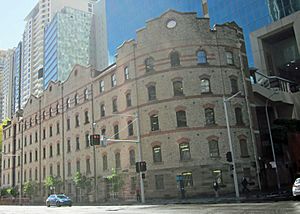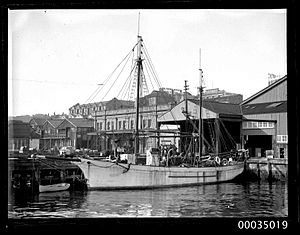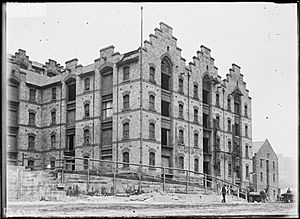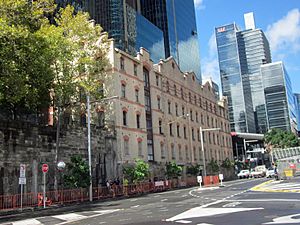Grafton Bond Store facts for kids
Quick facts for kids Grafton Bond Store |
|
|---|---|

Grafton Bond Store, facing north
|
|
| Location | Hickson Road, Millers Point, City of Sydney, New South Wales, Australia |
| Built | c. 1835; 1881; 1925; 1980s |
| Architect | William Wardell (1881 sections) |
| Owner | NSW Maritime |
| Official name: Grafton Bond Store and Sandstone Wall; Part of Maritime Centre; Price Waterhouse Building | |
| Type | State heritage (built) |
| Designated | 18 April 2000 |
| Reference no. | 1431 |
| Type | Office building |
| Category | Government and Administration |
| Lua error in Module:Location_map at line 420: attempt to index field 'wikibase' (a nil value). | |
The Grafton Bond Store is a very old building in Millers Point, a part of Sydney, Australia. It used to be a special kind of warehouse called a bond store. This meant it held goods that hadn't had their taxes paid yet. Today, it's used as offices.
The building's 1881 parts were designed by a famous architect named William Wardell. In the 1980s, it became part of the new Maritime Centre. This historic building was added to the New South Wales State Heritage Register in 2000 because it's so important.
Contents
A Look Back: The Grafton Bond Store's Story
The area where the Grafton Bond Store stands today was once called Cockle Bay. Around 1835, a place called Grafton Wharf was built there. This was a busy spot for ships to load and unload goods.
In 1881, a company owned by John Frazer bought the wharf. They made it much bigger! By 1886, it had a long waterfront along Darling Harbour. It also had three piers where ships could load and unload all sorts of cargo.
The complex had 14 warehouses. They could hold about 44,000 tonnes of goods. They could even press 1,600 bales of wool every day! People said it was the largest bond warehouse complex in Australia. The building we now call Grafton Bond was part of this huge complex.
In 1888, the stores became the property of Burns Philp & Co Ltd. Many parts of the complex were later removed. This happened because of a big economic downturn in 1893. Also, the Sydney Harbour Trust redeveloped the area.
In 1925, Hickson Road was built. This road cut right through the old Grafton Wharf site. Even this large building was changed then. But it still looks much like it did when William Wardell designed it. In the late 1980s, the Grafton Bond building was updated. It was successfully used again as part of the new Maritime Centre.
The old sandstone wall nearby is also important. It was built as the wharf area grew. It helped create a flat path to properties on Kent Street.
What the Grafton Bond Store Looks Like

The Grafton Bond Store stands out on Hickson Road. It's next to tall glass towers on Kent Street. This mix of old and new creates a striking view of Sydney from across the water.
The building is long and narrow. It has four or five floors facing Hickson Road. It has three floors above the rock shelf behind it. The front of the building has three sections with plain gables at the top. Some gables have steps, and one curves smoothly around the Napoleon Street corner. The lowest floor is made of sandstone.
The east side of the building once faced Jenkins Street. It has three stepped gables, like buildings you might see in northern Europe. Inside, the building has strong hardwood posts and beams. It also has timber floors. You can see some of the roof trusses, which are like strong wooden triangles that support the roof.
The walls are made of cream-coloured bricks. These bricks are thought to have come from Newcastle upon Tyne in Britain. They were probably used as ballast in sailing ships. The gables have the date 1881 on them. They also have a special design made of red bricks. This design is thought to be for John Frazer. The arches over the windows and doors are made of red-orange bricks.
The sandstone wall is a large cut into the natural rock. A stone wall was built on top of it. This made the wall taller and created a flat area for properties on Kent Street. There's now a park at the top of the wall. This wall used to mark the edge of the harbour. Now, it forms the eastern side of Hickson Road.
The building's unique "V" shaped bricks, stepped gables, and curved corner make its front very eye-catching.
Changes Over Time
Two of the original stores from 1881 were taken down in 1925. This was done to make Hickson Street wider. The building was updated when the Kent Street Maritime Building was built.
Two new sections were added to the east side of the old building. The larger one at the south end holds services and stairs. The smaller one at the north end has stairs and an elevator. They use similar shapes and colours. A three-level, partly glass walkway was added between these sections. The third store was removed in the 1960s.
In 1988, a lot of work was done to protect and update the building. This was part of building a new, modern building next to it. More recently, new sandstone walling was built to the north.
Why the Grafton Bond Store is Important
The Grafton Bond Store is a very important historical building. It's a reminder of what was once the largest bond store complex in Australia. It shows how busy the wharf area used to be. It also shows how important this large trading facility was to the city.
It's also beautiful to look at. It's a great example of useful city building design. It was designed by William Wardell, a famous Australian architect. His design shows a northern European style, especially with the stepped gables on the eastern side. The way it has been updated and placed next to modern glass towers is a very successful project.
The building also shows amazing craftsmanship. It was built very cleverly on the hilly land in Sydney.
The Grafton Bond Store was listed on the New South Wales State Heritage Register on April 18, 2000. This means it meets certain important standards.
- It shows the history of New South Wales.
The site is linked to the growth of wharves and trading in Sydney. It's a piece of what was said to be the biggest bond store complex in Australia. It's also part of the work of William Wardell, a very important architect from the 1800s. The sandstone wall is important because it shows how the wharf facilities grew.
- It shows great design and skill.
The Grafton Bond building is a very skilled design. It uses two colours of bricks and sandstone. The bricks were even brought from Britain! The style shows the northern European influence often seen in William Wardell's work. It stands out on its curved corner site. Its update and how it fits with the new, large buildings is a great example of reusing old buildings. The sandstone wall adds a lot to Hickson Road.
- It has a special connection to the community.
The sandstone wall is important because it stands out and adds to the area around Hickson Road.
- It can teach us about history.
The building shows excellent craftsmanship. It uses traditional materials and building styles. How it fits into the very steep, rocky site is amazing.
- It is rare or unusual.
Many unusual things about the building make it rare. This includes the use of very uncommon British bricks. It also shows a strong Dutch influence and has an unusual, gracefully curved end. This makes it a very rare example of warehouse design.
- It shows important features of its type.
The Grafton Bond building represents the historical development of wharves and trading in Sydney. It also represents the work of William Wardell, one of Australia's best architects.



